Where to Stay at Everest Base Camp in Tibet
Lying in the far west of Tibet, on the border with Nepal, Mount Everest is the foremost attraction in Tibet, and indeed in the entire Himalayas. Drawn by the mystical allure of this massive and iconic peak, tourists from around the world head for the famous Everest Base Camp in Tibet for the best views of the world’s highest mountain. Access to the base camp is done from Shigatse, Tibet’s second city, and the drive to EBC takes several hours, so it is not a day trip. Tourists regularly spend the night at the base camp in one of the two accommodation options available. The options available are the Rongbuk Monastery Guesthouse or the Tent Guesthouses at EBC. So which is better to stay in while visiting this massive peak?
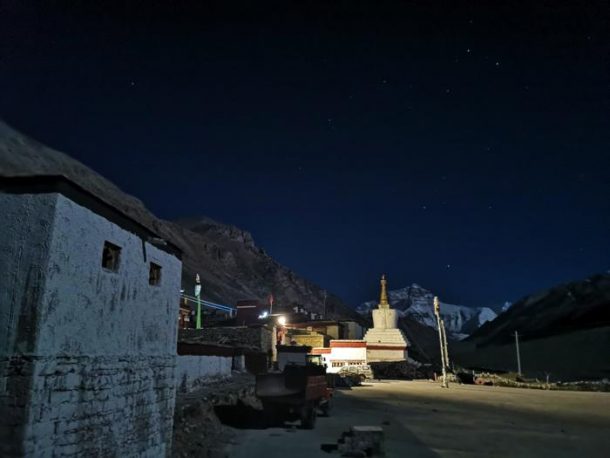
Table of Contents
EBC Tent Guesthouse
A great experience for tourists to EBC, the tent guesthouses are set up by locals around the newly-relocated base camp itself. The new base camp and tent guesthouses are a short distance from the Rongbuk Monastery, and just across the car park from the monastery guesthouse. The tent guesthouses are actually now around 4km from the famous Everest Milestone, with its height marker, which is still located at the old base campsite. From the peak of Mount Everest, it is exactly 11.56 miles or 18.61 kilometers as the crow flies.
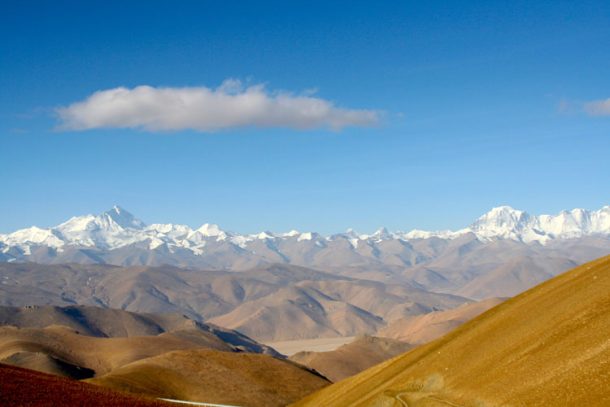
The tents are canvas and yak hair and normally sleep around 10-12 people. However, there are normally no individual beds as you would find in normal hotels. The seats around the outside of the tent double up as the beds as well, and aside from the tables for you to eat on, the only other furniture is normally a couple of wooden settles and the stove. You should bear in mind that you will be sharing with others that are staying there. The tent guesthouses do actually have bed linen for you to use, and it is normally clean and not smelly. However, it normally just consists of a quilted blanket and pillow, so it is a good idea to bring along a sleeping bag if you think you might not be warm enough in the tent.
The tent guesthouses are well heated, with the central stove of the tent providing heat as well as being used for cooking, heating water, and making the ever-present sweet Tibetan tea. However, there are no electric blankets in the tent guesthouses, though it is normally warm enough with your sleeping bag and quilted blanket. Facilities in the tents are pretty basic. There is no running water, but you can get cold water for washing, or the hosts will heat water for you on the stove.
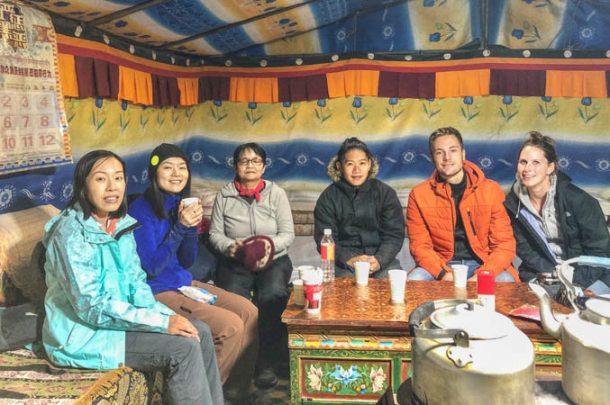
There are no indoor bathrooms, so prepare to forego your daily shower for one night. The tents do have electricity, but it is not available for 24 hours. Generally, the generators run until midnight to provide electricity for lighting, and you can charge your gadgets for a small fee until this time.
The food available at the tent guesthouses is basic Tibetan and Chinese cuisine, and normally includes such dishes as fried rice, noodles, pork, eggs, porridge, etc. If you are not a fan of the local food, then it is a good idea to bring your own supplies, as there is little choice available.
Rongbuk Monastery Guesthouse
The Rongbuk Monastery is located right next to the new base camp, and the monastery guesthouse is across the dirt road directly opposite. The Rongbuk Monastery Guesthouse has 30 rooms and can sleep a total of 100 guests overnight. Twin rooms are available if booked well in advance, while the main rooms can sleep from 5 to 10 people in each dorm.
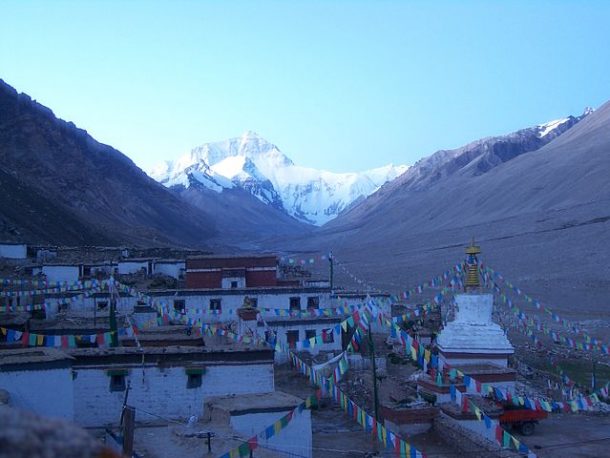
There are no single rooms. Bedding is available for all rooms and beds and includes electric blankets for staying warm at night. However, the state of the linen and bedding is not always as clean as you might prefer, so it is advantageous to bring your own sleeping bag if you are staying in the monastery guesthouse. Rooms also have a bowl for washing, a desk, and a few chairs, though the rooms have no internal heating.
You can get hot water and cold water at any time of the day, and electricity is sometimes available for 24 hours. However, Wi-Fi is still not available, though the cellphone signal is pretty good for calls and texts. The toilets in the monastery guesthouse are indoors, but they are very basic squat toilets, though cleaner than the outdoor ones at the base camp tent sites.
The monastery guesthouses do have food available, which is normally Chinese or Tibetan dishes that are simple and basic. You can also get plenty of coffee and sweet Tibetan tea to stay warm with. If you are not a fan of the local food, then it is advisable to bring your own packet and dried foods to eat.
Sightseeing Hotel
A three-story hotel now located opposite the Rongbuk Monastery, to the left side of the monastery guesthouse, this is the best of the accommodations available at the site, though it is also the more expensive. However, it is still no match for even the most basic hotel in towns and cities. The hotel has more than two dozen rooms, though only one shared toilet on each floor.
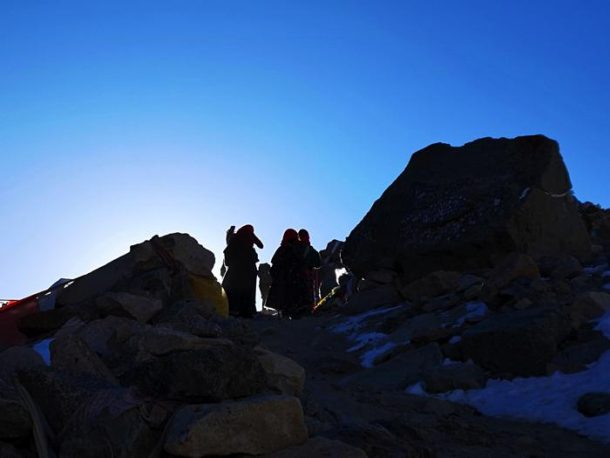
The rooms are fairly comfortable, considering the location, and contain twin or double beds, with simple toiletries and tap water available. However, there is no hot running water, and you will need to ask for hot water for a hot water bottle or for tea and coffee. The rooms do not have heating but do have warm and clean bedding and electric blankets.
The common areas of the hotel are nicely decorated in the traditional Tibetan styles, and are warm as well, heated by yak-dung stoves. The hotel also has a small dining room that serves a variety of Tibetan, Chinese, and Nepali dishes for your tastes.
Recent Posts
Top 5 Most Asked questions on Tibet Travel
7 Tips for a Successful Trip to Tibet
A Journey to Everest Base Camp in Tibet
All Categories
- About Tibet
- book a Tibet tour
- Buddhism Practice
- Budget Tour
- China-Tibet Train
- Customized Tibet tour
- Historical Sites
- Hot Springs in Tibet
- News
- Photography in Tibet
- Tibet attraction
- Tibet Group Visa
- Tibet Motorcycle Tour
- Tibet Small Group Tours
- Tibet Tours and Tibetan Tour Guide
- Tibet Train
- Tibet Travel FAQs
- Tibet Travel Information
- Tibet Travel News
- Tibet Travel Permit Update
- Tibet Travel Prices Rises
- Tibet Trek
- Tibet Trekking Tour
- Tibet weather and climate
- Tibet Wildlife animals
- Tibet Winter Tour
- Tibetan Buddhism
- Tibetan Cultural Features
- Tibetan Culture and Poeple
- Tibetan Festivals
- What to see in Tibet


